Fast prediction of aerodynamic noise induced by the flow around a cylinder based on deep neural network
Hai-Yang Meng(孟海洋) Zi-Xiang Xu(徐自翔) Jing Yang(杨京)Bin Liang(梁彬) and Jian-Chun Cheng(程建春)
1Key Laboratory of Modern Acoustics,MOE,Institute of Acoustics,Department of Physics,Nanjing University,Nanjing 210093,China
2Collaborative Innovation Center of Advanced Microstructures,Nanjing University,Nanjing 210093,China
Keywords: aerodynamic noise prediction,deep neural network,aeroacoustics
1. Introduction
Predicting the aerodynamic noise is of great significance for engineering fields of aeroacoustics and fluid mechanics. Besides expensive and complicated experiments,numerical simulation is also a general aerodynamic noise prediction method. With the development of aeroacoustics theory and computer science technology, methods based on computational fluid dynamics (CFD) and computational aeroacoustics (CAA) can solve flow problems numerically,predict acoustic fluctuations and simulate far-field acoustic propagation.[1–5]However, these methods are accompanied by some harsh requirements,[6]such as a good-quality time marching scheme, a suitably designed computation grid, and a set of radiation/outflow numerical treatments for use at the boundaries of the computation domain. These requirements demand enormous computing resources, which seriously affect the efficiency of aerodynamic noise prediction.The sound pressure level and directivity of far-field noise are the focus of research in practical engineering applications. Therefore, the establishment of a fast and accurate method to predict these attributes is of great significance to aeroacoustics prediction.
With the rapid development of data science, data-driven machine learning methods have the potential to augment or replace the expensive high-fidelity analyses with less expensive approximations. So far, machine learning has been widely used in the fields of fluid mechanics,[7–13]nonlinear dynamics,[14–17]and materials science and engineering.[18–22]Sekaret al.[10]presented a data driven approach for the prediction of incompressible laminar steady flow field over airfoils based on the combination of deep Convolutional Neural Network and deep Multilayer Perceptron. Pathaket al.[15]used a parallel reservoir computing approach to predict large spatiotemporal chaotic systems. Yeet al.[20]proposed a machine learning based approach to predict the effective elastic properties of composites with arbitrary shapes and distributions of inclusions. In recent years, researchers have also begun to explore the application of machine learning in aeroacoustics. Taoet al.[23]introduced artificial neural network to airframe noise reduction design, which achieved a significant airframe noise reduction effect and excellent aerodynamic performance simultaneously. Sanayeet al.[24]launched a genetic algorithm-based multi-objective optimization scheme to improve the efficiency of small wind turbine airfoil noise reduction design. Liet al.[25]developed a data-driven fastpredicting model of rotorcraft trailing-edge broadband noise,which can predict noise for the overall sound pressure level from basic rotor parameters.Nevertheless,the deep neural network(DNN)method for fast and accurate prediction of aerodynamic noise still needs further development.
In this paper, we develop a data-driven DNN framework for fast prediction of aerodynamic noise induced by the flow around a cylinder. The framework can predict noise for the overall sound pressure level (OASPL) under different inlet velocity and receiver’s spatial coordinates. The database for the network learning is generated using numerical simulation by solving Navier–Stokes equations and Ffowcs Williams–Hawkings (FW–H) acoustic analogy equations. Taking the receiver’s spatial coordinate(x,y)and inlet velocityU∞as inputs and OASPL as output, a neural network containing six fully connected layers is proposed with high consistency between prediction and the target OASPL. Moreover, the network shows good robustness, in extrapolate work conditions,the errors of prediction are below 0.82 dB. The directivity of aerodynamic noise predicted by the framework are basically consistent with the numerical simulation. Compared with traditional numerical methods, the trained DNN framework can get the results in only a few milliseconds, which greatly improves the efficiency of aerodynamic noise prediction. This work paves a novel way for fast prediction of aerodynamic noise with high accuracy and has application potential in acoustic field prediction.
2. Theory model and numerical simulation
2.1. Theory model
In aerodynamic noise simulation, the acoustic analogy method is often used for OASPL and spectrum prediction of far-field noise. Here, the FW–H acoustic analogy theory[26]is introduced in the numerical simulation, and the Lighthill equation[27,28]is obtained through the equivalent transformation of the Navier–Stokes equation:obtained[26]
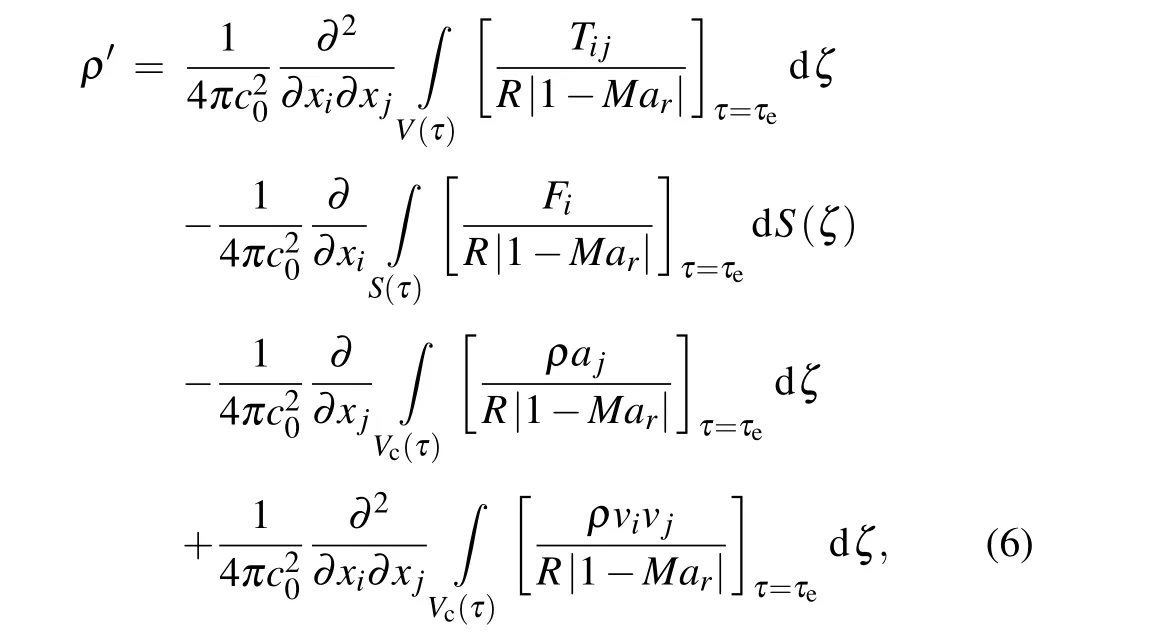
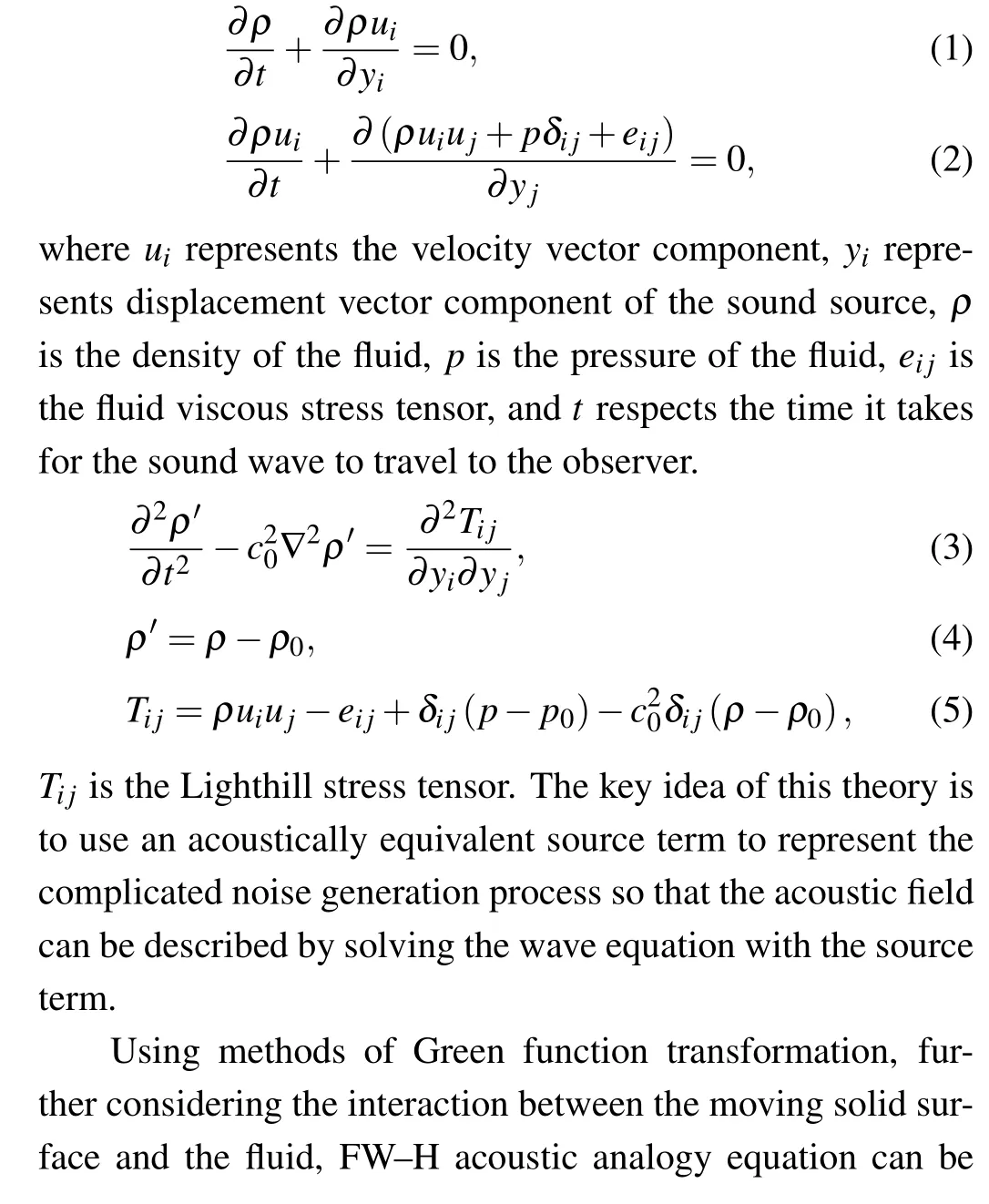
wherec0is sound speed in the far-field,Ris the geometric distance between the sound source and the sound field point,Fiis the external force,S(τ)andV(τ)are the surface area and the volume of the entire space except for the solids,Vc(τ) is the solid volume,viandajare the velocity and acceleration vector component of the moving solid in theζcoordinate system,xirepresents displacement vector component of the observer,Maris the projection of the moving Mach number of the observer direction,and[]τ=τesymbol indicates that the quantity in parentheses will be computed atζcoordinate system and delay timeτe.
Finally, in order to obtain OASPL, equation of state is used to construct the relationship between sound pressure andρ′:

Here,fis the frequency,pref=2×10-5Pa is the reference sound pressure.fmin=20 Hz andfmax=20 kHz are the lower and upper limit of the studied sound frequency,respectively.
2.2. Numerical simulation
Aerodynamic noise induced by the flow around a cylinder is a common problem in aerospace,navigation,wind engineering and other practical projects.[29,30]The aerodynamic noise characteristics of the flow around a cylinder is one of the factors that must be considered in engineering design and is also the basis of noise reduction design.Referring the experimental model conducted by Revellet al.,[31]we carried out numerical simulation through CFD.The two-dimensional numerical simulation physical model of aerodynamic noise generated by the flow around a cylinder we established is shown in Fig.1. The diameter of the cylinder is 19 mm, left boundary is set as the velocity inlet andU∞=69.2 m/s,and the right boundary is set as the pressure outlet. The upper and lower boundary are set as the symmetry.Smagorinsky–Lilly model of large eddy simulation is used in numerical simulation. The fluid medium is an incompressible ideal gas with a temperature of 300 K and a viscosity ofμ=1.7894×10-5kg/(m·s). The calculated time step is set as 5×10-6s. In order to verify the correctness of the numerical simulation method, we further carried out the numerical simulation of the aerodynamic noise generated by the flow around the cylinder with reference to the experiments of Liet al.[32]As shown in Table 1, the first two rows represent the comparison of the numerical simulation results with the experimental results of Revellet al.,and the last three rows represent the comparison of the numerical simulation results with the experimental results of Liet al.All the relative errors of the OASPL are less than 4%,which verifies the correctness of our numerical simulation method.

Table 1. Comparison of the OASPL obtained by experiments and numerical simulations.

Fig. 1. The two-dimensional numerical simulation physical model of aerodynamic noise generated by the flow around a cylinder.
3. Deep learning framework of aerodynamic noise prediction
The fundamental idea of the conventional prediction methods is to simulate unsteady flow and calculate the flow field information,including the space distributions of pressure,velocity and density by CFD,then CAA is used to extract the sound source information according to the CFD calculation results to solve the problem of acoustic radiation and propagation. The result of conventional prediction methods is mainly related to the construction of the geometric model,the setting of boundary conditions and initial conditions,the selection of calculation domain, and so on. The mapping relationship between the results and initial conditions, boundary conditions,geometric models and calculation domain is highly nonlinear. In recent years, deep learning has shown great application potential in nonlinear regression problems. Theoretically,a three-layer neural network can approximate any nonlinear function. Therefore, we try to introduce deep learning into aerodynamic noise prediction to replace traditional numerical simulation methods.
Here, we provide a deep learning method for aerodynamic noise prediction. The mapping relationship between input and output is constructed by DNN framework, so as to realize the rapid prediction of aerodynamic noise. As shown in Fig. 2, the method is divided into input module, nonlinear mapping module and output module.The function of the input module is mainly to provide input information for the method,including initial conditions,geometric models and calculation domain. Nonlinear mapping module is the core, which consists of several fully connected layers with a number of neurons in each layer, the number of neurons and hidden layers can be adjusted according to the complexity of the prediction problem. The first layer operates by constructing linear combination of the input module features and outputs the transformed features via a nonlinear activation function. The transformed output of the first layer is received by the second layer,and the operation continues layer by layer until the last layer,which connects the output module. In this way, the given input module features are mapped to the output module features in steps through a series of mappings. It is the main training part of the method and contains a lot of weights and biases.Finally,the output module provides the aerodynamic noise information we need.

Fig.2. Schematic diagram of the method for aerodynamic noise prediction.
4. Numerical experiments and results
In Section 3,we provide a deep learning method for aerodynamic noise prediction. It aims to uncover the hidden relationship between physical model parameters and the aerodynamic noise information.Next,we will verify the feasibility of the proposed method. We firstly establish a dataset of aerodynamic noise generated by the flow around a cylinder by CFD simulation. Taking the receiver’s spatial coordinate(x,y)and inlet velocityU∞as input,and the OASPL as output,a neural network containing six fully connected layers is proposed with high consistency between prediction and the target OASPL.Through the numerical experiments, we show that the implemented network can predict the OASPL of noise accurately within a few milliseconds.
4.1. Data preparation
High-fidelity CFD simulation results will be treated as the ground truth in our DNN prediction approach.Combined with the numerical simulation in Subsection 2.2, we only change the inlet velocityU∞(m/s)and the receivers’coordinates(x,y)of the receivers to create the database. The data set is divided into two parts: for the first part, the spatial coordinate of 100 receivers are shown in Fig.3(a),U∞several values from 10 to 100(U∞: 10,20,30,40,50,60,70,80,90,and 100)are considered,a total of 1000 cases are created;for the second part,the spatial coordinates of 36 receivers are shown in Fig.3(b),U∞values are set as 35, 55, 75, 95, 105, and 115, a total of 216 cases are created. Then,the first part is randomly divided into training and validation dataset in the ratio of 9:1;the second part is served as test dataset. The receivers of the second part are designed to demonstrate the directivity of the sound source and verify the ability of the DNN framework to predict its directivity.
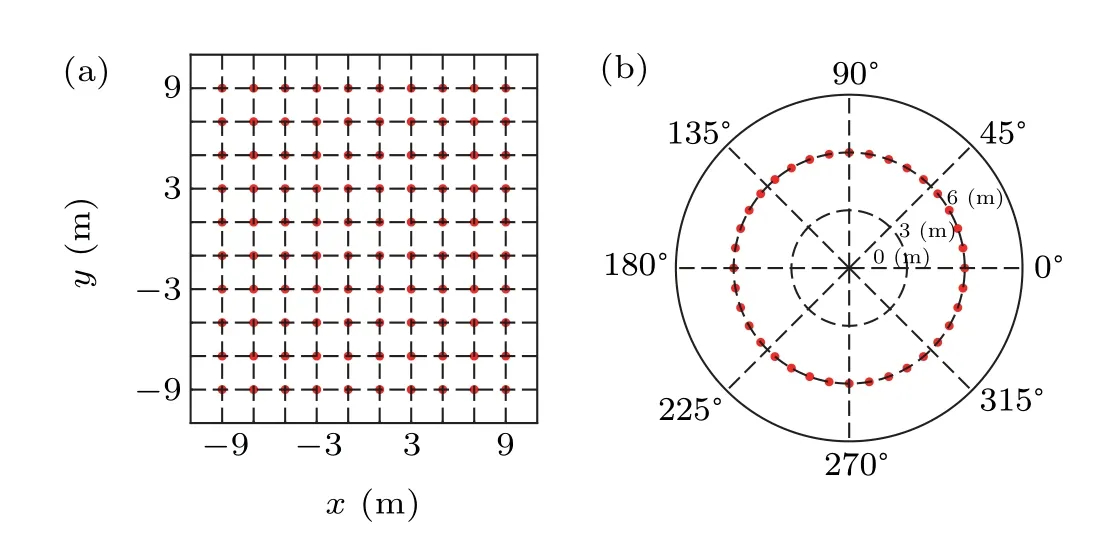
Fig. 3. (a) The spatial coordinates of receivers (100 red dots) for the train data. (b)36 receivers(red dots)are set at equal spacing within a radius of 6 meters for the test data.
4.2. DNN framework and results
Based on above method, as shown in Fig. 4, the DNN framework is used to predict aerodynamic noise induced by flow around the cylinder. The (x,y) coordinates andU∞are presented as the inputs of the framework; hidden layers consist of four fully connected layers with 500 units in each layer,Dropout[33]is a structure that can be used to reduce neural network over-fitting,which is used after every fully connected layer,and the dropout rate is set as 1%;OASPL serves as the output. ReLU[34]activation function

wherenis the batch size. And the parameters of the network are adjusted by backpropagation algorithm.[35,36]Adam optimizer combines the benefits of AdaGrad(for sparse gradients)and RMSProp (for online data) and doesn’t need to set step attenuation,which is used to converge our DNN framework.
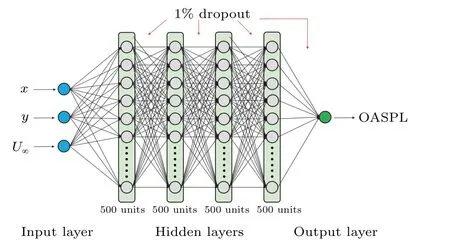
Fig.4. DNN framework used in the prediction of aerodynamic noise induced by flow around a cylinder.
Iterative adjustments are made using training dataset to minimize the loss function. The configuration of the computer is Intel(R) Core (TM) i7-4790 CPU @ 3.60 GHz. It is realized on the Anaconda platform with python version 3.7.9. It is difficult to establish large-scale aerodynamic noise database because of the heavy workload of numerical simulation method. For the small training samples in this paper,in addition to adding Dropout structure between neural network layers,we further adopt early stopping technique to prevent over-fitting problems. Compute its performance on the validation dataset during training of the DNN framework and stop training when the performance degrades. The root-meansquare-error (RMSE) of results yielded by the DNN framework in the verification set is 0.99 dB. The results for the verification set predicted by the DNN framework are plotted against those generated by CFD simulation in Fig. 5. Those points are concentrated in the vicinity of the dashed liney=x,indicating that the proposed DNN framework can perfectly learn the nonlinear mapping between the coordinate location,inlet velocity and the OASPL.

Fig.5. OASPLs of DNN framework prediction compared with CFD results.The black line(dashed)is the identity line serving as the reference.
In the first part of the dataset, we only perform a simple validation of the prediction performance of the DNN framework. To further investigate the learning ability of the model,it was thoroughly tested with the second part of the dataset.The results of test dataset demonstrate that the DNN framework works well also for other inlet velocity and receivers that have not been encountered in the preceding training process.Meanwhile,the directivity of aerodynamic noise predicted by the framework is also in good agreement with the results of CFD simulation, as shown in Fig. 6. Noted thatU∞=105 andU∞=115 are outside the training inlet velocity range,the DNN model still has good prediction accuracy, which shows that the trained DNN framework avoids the problem of overfitting. In addition, RMSE is served as a test metric for our DNN model to quantify the predictive performance. Table 2 shows the RMSE of results predicted by DNN framework for the test dataset. All RMSEs are below 0.82 dB.Furthermore,we compare the time required by DNN method and traditional CFD method to predict OASPL at the same receivers under different inlet velocity conditions. The configuration of the computer is Intel(R)Core(TM)i7-4790 CPU@3.60 GHz.
As shown in Table 3, compared to CFD numerical simulations, which take thousands of seconds to obtain results,DNN methods can complete predictions in milliseconds while maintaining accuracy. The calculation speed differs by four orders of magnitude, which highlights the advantages of the DNN approach in terms of computational speed and prediction accuracy.

Table 2. RMSE of results predicted by DNN framework for the test dataset.

Table 3. Comparison of prediction time between DNN framework and CFD method.
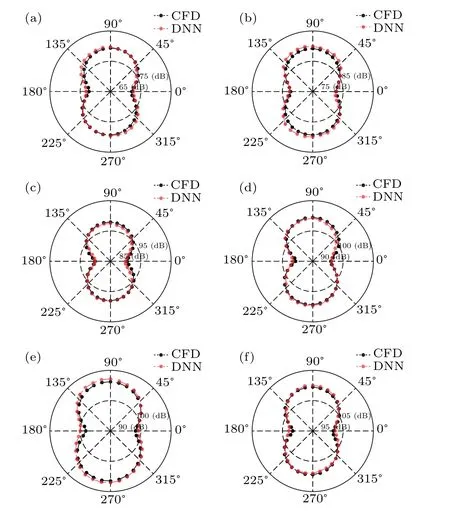
Fig.6. In the test dataset,the prediction results of DNN framework are compared with the results of CFD software. When U∞(m/s) value equal to 35,55, 75, 95, 105, and 115, figures of the OASPL values predicted by DNN framework versus CFD results for 36 receivers are(a),(b), (c), (d), (e), and(f)respectively.
5. Conclusion
In conclusion,we propose a data-driven DNN method to tackle the challenge of predicting aerodynamic noise with high accuracy and efficiency. To verify the feasibility of the proposed method,a two-dimensional model of aerodynamic noise caused by flow around a cylinder is introduced and the corresponding dataset is built. A DNN framework is judiciously developed to predict the OASPL of above aerodynamic noise model. The prediction results show our framework can accurately and efficiently predict the OASPL of aerodynamic noise with given inlet velocity and calculated domain coordinates.Meanwhile,the directivity of aerodynamic noise predicted by the framework is basically consistent with that of numerical simulation. It is worth noting that only the two-dimensional case of aerodynamic noise generated by flow around a cylinder is discussed in this paper. Different from the aerodynamic noise problem caused by the flow around a cylinder,when predicting the aerodynamic noise of irregular bluff bodies such as aircraft landing gear and automobile rear-view mirrors,we must consider the flow field and sound field changes caused by the geometry changes of bluff body. Therefore,the geometric characteristics of the bluff body become one of the important characteristics that affect the aerodynamic noise caused by the flow around it. However, unlike the cylinder, the geometric features of irregular bluff bodies are difficult to be characterized by several geometric parameters. Fortunately, convolutional neural networks are widely used in the field of computer vision due to their excellent feature extraction capabilities.We can introduce the convolutional neural network(CNN)in the input module to extract the geometric features of the irregular bluff body as one of the inputs of the nonlinear module.Combined with CNN,the proposed DNN method can be easily extended to predict aerodynamic noise caused by the flow around more complex geometries. This work provides a novel way for fast and accurate prediction of aerodynamic noise,and has application potential in prediction of acoustic field.
Acknowledgments
Project supported by the National Key Research and Development Program of China(Grant No.2017YFA0303700),the National Natural Science Foundation of China (Grants Nos.12174190,11634006,12074286,and 81127901),the Innovation Special Zone of the National Defense Science and Technology, High-Performance Computing Center of Collaborative Innovation Center of Advanced Microstructures,and the Priority Academic Program Development of Jiangsu Higher Education Institutions.
- Chinese Physics B的其它文章
- Ergodic stationary distribution of a stochastic rumor propagation model with general incidence function
- Most probable transition paths in eutrophicated lake ecosystem under Gaussian white noise and periodic force
- Local sum uncertainty relations for angular momentum operators of bipartite permutation symmetric systems
- Quantum algorithm for neighborhood preserving embedding
- Vortex chains induced by anisotropic spin–orbit coupling and magnetic field in spin-2 Bose–Einstein condensates
- Short-wave infrared continuous-variable quantum key distribution over satellite-to-submarine channels

